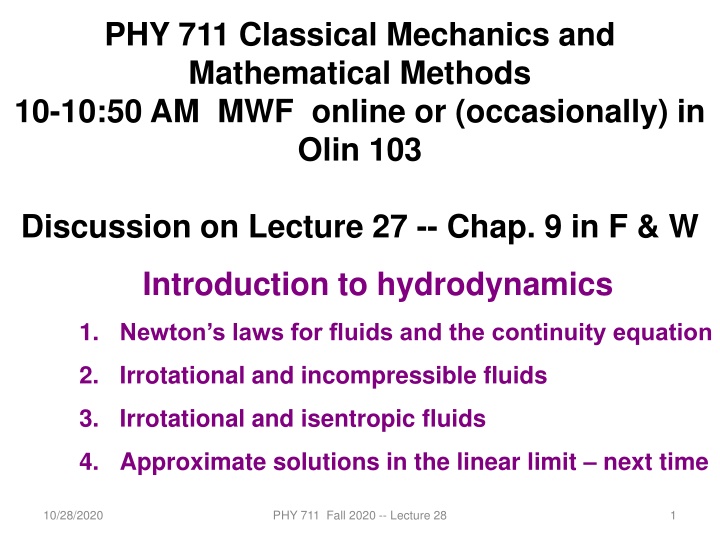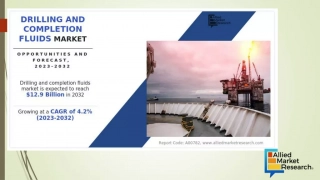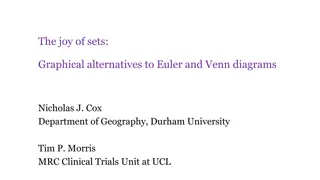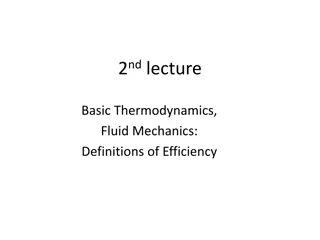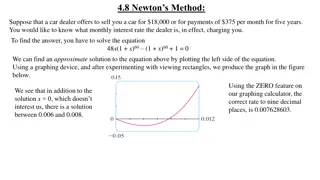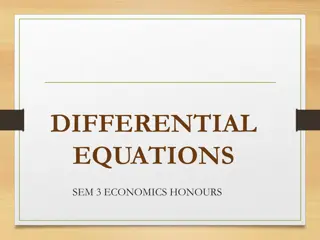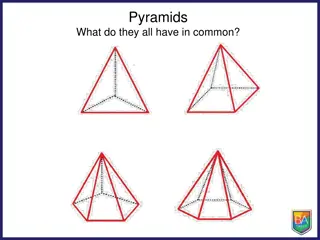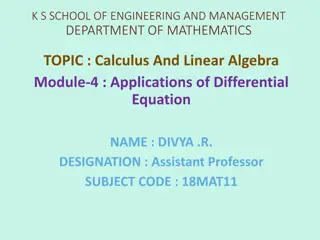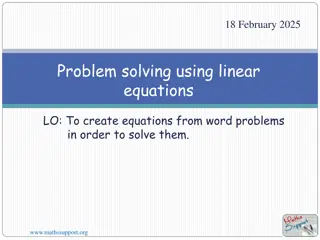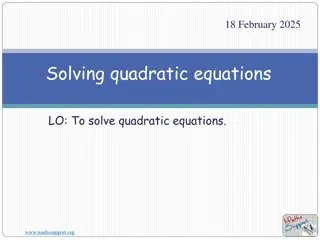Introduction to Newton's Equations for Fluids and Euler Analysis
This lecture delves into Newton's laws for fluids, exploring topics like the continuity equation, irrotational and incompressible fluids, and velocity potential derived from zero velocity curl. The class discusses the physical insights behind variables like epsilon, examines the significance of the continuity equation, and connects it to broader applications. Additionally, the lecture covers the properties of fluids described using Euler formulation and delves into particle behavior and analysis in fluid mechanics.
Download Presentation

Please find below an Image/Link to download the presentation.
The content on the website is provided AS IS for your information and personal use only. It may not be sold, licensed, or shared on other websites without obtaining consent from the author.If you encounter any issues during the download, it is possible that the publisher has removed the file from their server.
You are allowed to download the files provided on this website for personal or commercial use, subject to the condition that they are used lawfully. All files are the property of their respective owners.
The content on the website is provided AS IS for your information and personal use only. It may not be sold, licensed, or shared on other websites without obtaining consent from the author.
E N D
Presentation Transcript
PHY 711 Classical Mechanics and Mathematical Methods 10-10:50 AM MWF online or (occasionally) in Olin 103 Discussion on Lecture 27 -- Chap. 9 in F & W Introduction to hydrodynamics 1. Newton s laws for fluids and the continuity equation 2. Irrotational and incompressible fluids 3. Irrotational and isentropic fluids 4. Approximate solutions in the linear limit next time 10/28/2020 PHY 711 Fall 2020 -- Lecture 28 1
Schedule for weekly one-on-one meetings Nick 11 AM Monday (ED/ST) Tim 9 AM Tuesday Gao 9 PM Tuesday Tim 11 AM Wednesday Jeanette 11 AM Friday Derek 12 PM Friday 10/28/2020 PHY 711 Fall 2020 -- Lecture 28 2
10/28/2020 PHY 711 Fall 2020 -- Lecture 28 3
Thursday Oct. 29, 2020 at 4 PM 10/28/2020 PHY 711 Fall 2020 -- Lecture 28 4
10/28/2020 PHY 711 Fall 2020 -- Lecture 28 5
10/28/2020 PHY 711 Fall 2020 -- Lecture 28 6
Your questions From Tim 1. Is there any physical relationship with the variable epsilon on slide 19? From Nick 1. Can you spend some time going over the big picture of the continuity equation, and where it comes from and what is means? Are we just working with an example of a continuity equation here, or is this same one applied elsewhere? From Gao 1. About today's lecture, Why do zero velocity curl lead to velocity potential? 10/28/2020 PHY 711 Fall 2020 -- Lecture 28 7
Newtons equations for fluids Use Euler formulation; properties described in terms of stationary spatial grid : Variables (x,y,z,t) Density Pressure p(x,y,z,t) (x,y,z,t) v Velocity t r Particle at : , t t + t = r v Particle at : ' t ' , t t + ' t t t 10/28/2020 PHY 711 Fall 2020 -- Lecture 28 8
Euler analysis -- continued r Particle at : , Particle at ': For ( , ): f df dt df f dt t t t t + , ' where t t v = r ' t t t r t + v ( , ') r ( , ) r r ( , ) r ( , ) t t f t f t f f t lim t = + t t 0 ( ) = + v f 1 2v ( ) ( ) = v 2 v v v It can be shown that: 10/28/2020 PHY 711 Fall 2020 -- Lecture 28 9
df dt f t ( ) = + v f dv dt dv dt dv dt d dt v ( ) = + v For f v v x x x x t v ( ) y y = + v For f v v y y t v ( ) = + v For f v v z z z z t v v ( ) = + v v In vector form t ( ) ( ) = + + + + v v x y z Note that v v v v v v x y z x y z x y z 10/28/2020 PHY 711 Fall 2020 -- Lecture 28 10
v v d dt ( ) = + v v In vector form t ( ) ( ) = + + + + v v x y z Note that v v v v v v x y z x y z x y z 1 2 ( ) 2 v v v = 10/28/2020 PHY 711 Fall 2020 -- Lecture 28 11
Continuity equation: + + ( ) = v 0 t ( ) ( + ) = v v 0 t The notion of the continuity is a common feature of continuous closed systems. Here we assume that there are no mechanisms for creation or destruction of the fluid. = ( ) v t ( ) v t 10/28/2020 PHY 711 Fall 2020 -- Lecture 28 12
Continuity equation: + + ( ) = v 0 t ( ) ( + ) = v v 0 velocity potential t ( ) = For incompressible fluid: 0 Irrotational flow: For irrotational flow of an incompressible fluid: constant = v = = v v 0 = 2 0 10/28/2020 PHY 711 Fall 2020 -- Lecture 28 13
Your question = v v W hy d oes 0 imply that = + ? = + x y z Consider: x y z 2 2 ( ) = = 0 Similar results or other direct ons f i . y z z y x 10/28/2020 PHY 711 Fall 2020 -- Lecture 28 14
Example uniform flow b a z = 2 0 x Possible = y z 2 2 2 + + = 0 2 2 2 solution z = : v o = v z v o 10/28/2020 PHY 711 Fall 2020 -- Lecture 28 15
Example flow around a long cylinder (oriented in the Y direction) ^X r=a v0Z^ v0Z^ ^Z = 2 0 r = 0 =a r 10/28/2020 PHY 711 Fall 2020 -- Lecture 28 16
Laplace equation cylindrica in coordinate l s representi y + in the motion no is there case, our In = ( defined r, , in plane; x-z cylinder ng axis) 2 2 1 r 1 r = = + 2 0 r 2 2 2 r r y y dimension ( boundary From ) ( ) , , , r y r ( ) = condition : v r v 0 z ( ) ( ) = = , cos r v r v r 0 0 z 2 cos = Note that : cos 2 ( ) = Guess form : , cos r f(r) 10/28/2020 PHY 711 Fall 2020 -- Lecture 28 17
Necessary equation for radial function 1 r 1 r f = 0 r f 2 r r B = + ( ) where , constants are B f r Ar A r Boundary condition cylinder on surface : = 0 r = r a df B = = = ( ) 0 r a A 2 dr a = 2 B Aa = Boundary condition at : A v 0 10/28/2020 PHY 711 Fall 2020 -- Lecture 28 18
2 a r ( ) = + , cos r v r 0 2 a r = = 1 cos v v 0 r 2 r 2 1 r a r = = + 1 sin v v 0 2 For v r s n i = r z cos v v v 0 0 0 ^X v0Z^ r=a v0Z^ ^Z 10/28/2020 PHY 711 Fall 2020 -- Lecture 28 19
Now consider the case of your homework problem -- For 3-dimensional system, consider a spherical obstruction Laplacian in spherical polar coordinates: 1 0 r r r r r 2 1 sin 1 = = + + 2 2 sin 2 2 2 2 2 sin r 10/28/2020 PHY 711 Fall 2020 -- Lecture 28 20
Spherical system continued: Laplacian in spherical polar coordinates: 1 0 r r r In terms of spherical harmonic functions: + 2 1 sin 1 = = + + 2 2 sin 2 2 2 2 2 sin r r r 2 1 1 ( ) ( ) = + sin , ( 1) , Y l l Y lm lm 2 2 sin In our case: sin 3cos 4 ( ) f r Y ( ) = , Y 10 = ( , + ( , , ) r d ) lm 1 r dr ( 1) df dr l l (Continue analysis for homework) = 2 0 r f 2 2 r 10/28/2020 PHY 711 Fall 2020 -- Lecture 28 21
Solution of Eulers equation for fluids ( v t ) v p ( ) + = 2 v v f 1 applied 2 Consider the following restrictions: 1. 0 "irrotational flow" 2. conservative applied force applied U = ( ) v = = = v f 3. (constant) incompressible fluid ( ) t ( ) p + = 2 v U 1 2 t p + + = 2 0 U v 1 2 10/28/2020 PHY 711 Fall 2020 -- Lecture 28 22
For incompressible fluid Bernoulli s integral of Euler s equation for constant p U v t + + = 2 0 1 2 Integrating over space: p U v v + + = 2 ( ) C t 1 2 t ( ) = = + ( , ) r ( , ) r where ( ) t t C t t + r ( , ) r It is convenient to modify ( , ) ( ') ' t t C t dt p + + = 2 0 Bernoulli's theorem U v 1 2 t 10/28/2020 PHY 711 Fall 2020 -- Lecture 28 23
Not all fluids are compressible, but with additional work we can consider fluids at constant entropy (no heat transfer). Under what circumstances can there be no heat transfer? 10/28/2020 PHY 711 Fall 2020 -- Lecture 28 24
Solution of Eulers equation for fluids -- isentropic ( ( v t ) v p ) + = 2 v v f 1 applied 2 Consider the following restrictions: 1. 0 "irrotational flow" 2. conservative applied force applied U A little thermodynamics First law of thermodynamics: For isentropic conditions: dE dW pdV = = ( ) v = = = v f 3. (constant) isentropic fluid = dE = dQ dW int 0 dQ int 10/28/2020 PHY 711 Fall 2020 -- Lecture 28 25
Solution of Eulers equation for fluids isentropic (continued) = = dE dW pdV int M V = In terms of mass density: M V M E = For fixed and variable : M V d dV 2 = dV d 2 = In terms in intensive variables: Let M int p = = = = dE Md dW pdV M d int 2 p p = = d d 2 2 = 0 dQ 10/28/2020 PHY 711 Fall 2020 -- Lecture 28 26
Solution of Eulers equation for fluids isentropic (continued) p = 2 = 0 dQ p = = Consider : 2 = 0 dQ p p + = Rearrangin g : Is this useful? a. Yes b. No 10/28/2020 PHY 711 Fall 2020 -- Lecture 28 27
Solution of Eulers equation for fluids isentropic (continued) ( ) v p ( ) + = 2 v v f v 1 applied 2 t p p 0 = + = = = v v f U applied ( ) t ( ) p + = + 2 v U 1 2 t p + + + = 2 0 U v 1 2 10/28/2020 PHY 711 Fall 2020 -- Lecture 28 28
Summary of Bernoullis results For incompressible fluid t p + + = 2 0 U v 1 2 For isentropic fluid with internal energy density t p + + + = 2 0 U v 1 2 Here is the internal energy of the fluid per unit mass. For an ideal gas fluid, it has a relatively simple form. 10/28/2020 PHY 711 Fall 2020 -- Lecture 28 29
